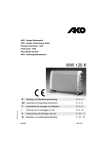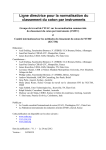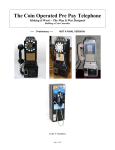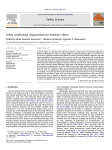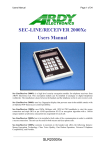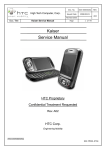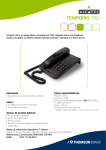Download November 2004 - Telephone Collectors International
Transcript
Telephone Collectors International Singing Wires Newsletter Volume 18, Number 11 Inside this issue . . . Henry Dreyfuss Industrial designer and the father of modern telephone design. Pg 4 The 2004 Fall Enfield Regional Show [and photos] Pg 7 The Book on Blake Pg 11 Summary of TCI Board Action Pg 8 TCI Dues Structure, 2005 Pg 8 A Collector's Online Adventure Finding Hidden Treasure Pg 9 The Norfolk Cutover Ceremony on November 9, 1919 Pg 10 "The Telephone Settlement" Pg 12 Buy-Sell-Trade Pg 13 Antique Telephone Show Coming Up Soon! Southeast Regional Show January 15, 2005 See Page 6 for details . . . November 15, 2004 The Dutch Universal Telephone TYPE 65 by Remco Enthoven Since the invention of the telephone, there has always been a large variety in shape and appearance of the telephone apparatus. If one considers that wall telephones used in a local battery system need to have room for two rather large cells that provide the microphone current, one can imagine that such an apparatus will be fairly large in size. Apparatus for central battery systems can be made much smaller because of the lack of mentioned cells and a generator that was used to signal the operator at the start and end of a call. Due to a relatively small market (e.g. compared to Germany and the United Kingdom), Dutch PTT was forced to order telephones from various manufacturers that produced a variety of phones. Besides the different telephones, different parts also had to be in stock in order to repair or refurbish the apparatus. Therefore telephone repairmen were forced to carry a large supply of different parts with them as they didn’t know what type of telephone was going to be present at the subscriber’s premises. Because of their huge needs, telephone companies in Germany and the United Kingdom could demand technical and design standards and the manufacturers that could and would meet these demands were allowed to supply. In the early 1960’s, technicians of the Dutch PTT started the development of a standard telephone that differs only in the design of the body of the table or wall version. The inside of both table and wall telephone (electrical characteristics) is the same and the handset (acoustic characteristics) is the same. DON'T FORGET TO RENEW YOUR MEMBERSHIP FOR 2005! SEE RENEWAL FORM INSIDE. They adopted a large simplification of repair, maintenance and revision activities by: a. Extensive standardization, which led to a large reduction in the variety of spare parts needed. b. Improvement of quality of parts resulting in a lesser fault percentage. c. Constructing the apparatus in such a manner that parts can be easily replaced which minimizes on-site repairs. In 1965, a new standard telephone was being developed by Dutch PTT in close cooperation with the German manufacturer, Krone: The T 65. The German firm, Krone, designed the case. There is some talk of plagiarism, as the T 65 looks very much like the new phone of the German Bundespost, the Fe Ap 61 (1961), Fe Ap 61 (1961) but also resembles the Dialog (1962), made by Ericsson Sweden. The T 65 In 1966, the newly developed standard telephone T 65 (T stands for Tafeltoestel / table phone, 65 for the year the development ended), was introduced to the public, in grey. The phones are made of an ABS, an unbreakable plastic, and have a light greenish grey color. The dial, bottom plate, and connection cords are cream colored. The insight and studies of the Dutch professor H. Mol from Rotterdam played a major role in the design of the technical part. Change of Address??? Don't miss an issue of the Singing Wires newsletter because you forgot to give us your new address. Send new address to: David Massey 2853 Spicewood Lane Kennesaw, GA 30152 USA or email your new address to [email protected] Page 2 LM Ericsson Dialog (1962) The T 65 was produced by German Krone (located in Germany) and under license by Dutch Ericsson (located in Rijen the Netherlands), NSEM (Nederlandse Standard Electric Maatschappij, located in The Hague the Netherlands) and HEEMAF (Hengelosche Electrische En Mechanische Apparaten Fabriek, located in Hengelo the Netherlands). The make is only recognizable on the outside by the trademark of the manufacturer on underside of the bottom plate. On the inside, the manufacturers used their own parts that were made to meet the specifications of the Dutch PTT. For example, Krone and Ericsson used their own dials, NSEM used an ITT dial and HEEMAF used the Krone dial. The construction of the Krone dial mechanism is very different from other dials. It uses an ingenious mechanism that contains two small metal balls which operate the pulse contact instead of the cogwheel that is normally used. TCI Leadership (Name, Office, E-mail, Phone) Gerald Neal, ’06, President [email protected] 847-742-7135 Ray Kotke, ’07, Vice President [email protected] 517-641-4953 Sam Corcione, ’06, Treasurer [email protected] 847-329-7664 Roger Conklin, ’06, Secretary [email protected] 305-238-5857 Gary Goff, ’07, Membership Secretary [email protected] 714-528-3561 Walt Aydelotte, ‘07, BOD [email protected] 609-818-1698 Russ Fierce, ‘05, BOD [email protected] 847-358-1185 George W. Howard, ‘05 [email protected] 315-824-1399 Chris Mattingly, ‘05, BOD 314-921-6877 ext 31 John Novack, ’07, BOD [email protected] 304-274-9079 Phil Schelthoff, ’05, BOD [email protected] 630-833-0447 Ken Sims, ’06, BOD [email protected] 502-499-1457 Jim Stettler, ‘05, BOD [email protected] 719-635-9537 Wally Tubbs, ‘06, BOD [email protected] 402-423-4716 Mike Magnus, Switchers Quarterly Editor [email protected] 847-824-0374 David Massey, Editor Singing Wires [email protected] 770-426-5715 Paul Wills [email protected] 610-384-4250 Paul & Bev McFadden, Editor Emeritus [email protected] 847-658-7844 TCI Phone: 801-849-6520 NOVEMBER 2004 TCI SINGING WIRES Underside of the T65 The T 65 was designed with maximum comfort for the user in mind. The phone was meant to be moved more easily and therefore is much lighter than its predecessors. In order to make the phone more portable, it is fitted with a handle on the back. In addition, the weight of the handset has been reduced by half, making the phone easier to use, T 65 especially for the handicapped. The volume of the ringer was adjustable from the level of a buzzer to loud ringing. The small hatch on the underside of the telephone makes it is very easy to connect various ancillary equipment such as an external ringer, mother-in-law receiver, counter, recording machine, automatic dialer, and speaker phone, without opening the telephone itself. The T 65 type telephones have a special provision that makes it possible to connect two T 65 type telephones to a public telephone line in a special manner. In Dutch it’s called a “tweeling” or “tweepuntschakeling” which translates into “two point” or “twin connection”. This configuration consists of two T 65 type telephones connected together with nothing more than copper wire, both phones ring on incoming calls and when a call is answered with one T 65 the other one is excluded from the conversation. In English it´s called “extensions in parallel with privacy arrangement”. The white button, on the Type T 65, is the so-called “earth (ground)” button. It is the forerunner of the “flash” button* (which momentarily opens the line) which is for use in connecting a caller with someone else on a PABX. A special GDK (Gelijkstroom Druktoets Kiezen / DC current pushbutton dialling) version of the T 65 was produced for use with a PABX that was developed by Philips. The T 65 had to be rented from Dutch PTT by the subscriber for a monthly fee. Today telephones in the Netherlands no longer need to be rented; it is allowed to connect any telephone as long as it is approved. During the second quarter of 1967, the newly developed standard telephone W 65 (W=Wandtoestel/ wall phone), was introduced to the public, in grey. in order to facilitate a short interruption of the conversation. At the end of 1970 the new “Drielingtoestel Type T 65” (Drieling=Triplets) was introduced to the W 65 public, in grey. The Drielingtoestel Type T 65 was a system providing direct access from any one of three stations to an exchange line, with signalling between stations. Drielingtoestel Type T 65 W 65 The W 65 was also developed in close cooperation with the German firm, Krone. The design of the W 65 makes it possible to hang the handset on the site of the telephone Colored versions of the T 65 were introduced in the Arnhem telephone district on October 1 1972. At the introduction, the T 65 “de Luxe” was available in five colors: Emerald green, azure blue, ruby red, ivory, and orange. Only the table model (T 65) was made in other colors than grey. The colored T 65 “de Luxe” becomes available nationwide on October 15 1973. Colored T 65´s in ruby red, orange, emerald green, azure bleu, black, ivory and mocha Article to be Continued in Next Month's Issue NOVEMBER 2004 TCI SINGING WIRES Page 3 Henry Dreyfuss Industrial designer and the father of modern telephone design. Jonathan D. Finder, MD It’s impossible to overestimate the Consideration of physical importance of the work of Henry Dreyfuss, users’ and his associates in his design firm, Henry c h a r a c t e r i s t i c s Dreyfuss Associates on modern design. included not only their Henry Dreyfuss called himself an “industrial measurements but designer,” a phrase that evokes steel mills such dimensions as amount of and automobile assembly plants. In fact, his the work was far more centered on what we now pressure that felt call “the user” – the average person using comfortable in, for the item he designed. His autobiography, example, pressing a Dreyfuss’ published in 1955, is must reading for button. anyone who wants to understand this man. extremely exacting and He was a creative genius, a leader, and a thorough set of was person for whom design was intended to standards serve his fellow man. Designing for People, published originally as published in 1955 by Simon and Schuster, “The Measure of was itself a striking bit of design work, with Man” and later “The Ericsson telephone, which preceded and wonderful hand-drawn sketches in the Measure of Man and influenced the WE302 margins, clear fonts, and plenty of Woman.” This book is illustrations. Its title really summarizes what still in print and is available as a CD database (see http:// involved in the design of the phone “from his career concerned: people. the inside out” and thereby created a design It’s useful to start a discussion of Henry www.hda.net/). The beauty of Dreyfuss’ designs is that in harmony with the engineers of Bell Dreyfuss with his own words. In reply to the question, “How do you start an industrial they are so omnipresent that they have Telephone Laboratories. The design of the WE302 was not become part of our surroundings. How design problem?” he answered: “We begin with men and women and we many of us have used the circular gold Dreyfuss’ finest achievement. Rather, it was end with them. We consider the potential Honeywell thermostat without wondering his first major work. He began with a design who designed it? This problem, which was combining the dial, users’ habits, was, of course, a Dreyfuss handset, and switchhook with the contents physical dimensions, design, and one still in use of the “subscriber set” (bells and network). and psychological in millions of homes. He The WE202 or B1 handset mounting with its impulses. We also and his firm designed E1 handset was, despite my fondness for the measure their pulse, thousands of household set, a rather awkward design. The handset which is what I meant items (yes, including the was oversized and cumbersome, and heavy by ending with them, kitchen sink) but it is the to hold for a prolonged period. The base for we must conceive telephone that appears to used a single plunger. One has to bear in not only a be the item about which he mind that Bell was behind the curve when it satisfactory design, Western Electric Model 302 was most proud. He wrote, came to creating a “combined” set (with a but also one that “Of all the magic of modern base containing all components, requiring incorporates that indefinable appeal to assure purchase. The civilization, the telephone seems to me the no subset or “ringer box”). Several other Greek philosopher Protagoras had a most wondrous achievement.” He spoke of telephone manufacturers had combined phrase for it, ‘Man is the measure of all the “wonderful democracy of the sets in use well before 1937 when the WE302 things’” [Designing for People, Simon and telephone” as a technology readily available came out – including the Kellogg 925, the to all. The telephone, said Dreyfuss, is “a Stromberg Carlson 1212, the AE #2 Schuster, 1955, p. 219]. Monophone, as well as several European Dreyfuss pioneered the use of personal thing.” Henry Dreyfuss’ involvement with phones. Dreyfuss worked with Bell ergonomics. This required the measurement of thousands of people to create an telephone design began with his design of Laboratories to create the first combined set exceedingly precise set of standards on the WE302 for Bell Telephone in 1937. Unlike for the Bell System. He used the same kind which his firm would base all designs. other designers, he insisted on being of dial (3 inch dial) as was used by the Page 4 NOVEMBER 2004 TCI SINGING WIRES WE202, allowing for reuse of an expensive component. In both the WE302 and the B1 handset mounting, the dial was mounted directly to the shell. Both sets originally had cast metal alloy shells (later the WE302 would be made of an early plastic, cellulose acetate butyrate). Interestingly, his design borrowed strongly from a bakelite telephone of the same era, the Ericsson desk set (see figure). Dreyfuss always used the competitors’ models in creating a new design, and the combined sets of Europe were a good starting point. Comparing the WE302 to the Ericsson model, both sets had concave sides, both models had the dial mounted to the case, and both models had the ringer mounted to the base. The major difference was in the components, designed by Bell Labs. The transmitter was much more forgiving of being used at different angles, and the network was much smaller and compact enough to fit inside a compact base. It would be only 10 years later that Bell assigned Henry Dreyfuss Associates the task of creating a new telephone to replace the WE302. Dreyfuss by this time had established his “five points” of design: “…first convenience of use, including utility and safety; second, ease of maintenance; third cost of manufacture and distribution; fourth, merchandising and competition. And last, but not least, we consider appearance.” These factors would be critical in the creation of a new telephone for the Bell System. In researching the design of a new telephone, Henry Dreyfuss actually accompanied telephone repairmen on their rounds, in order to see first hand how telephones (still considered a new technology) were being used and the kinds of problems faced by the installers (covering the first and second points above). This research actually led to an awkward moment that he described in his autobiography: "Because placement [of the telephone within the home] had a bearing on design, we had to determine what people did with phones, and that is why the telephone company permitted me to act as a repairman’s helper when he went on his rounds. My research ended abruptly when I went up in the service elevator of an apartment house and was ushered through the kitchen into the living quarters of a family I knew. There was my hostess of a previous evening greeting me in some confusion and seemed surprised that a man who had represented himself as an industrial designer should be repairing telephones." Design flaws in the WE302 led to a project to create an entirely new telephone, one that would look modern, be easy to use, and have a design that would stand up to the projected life-span of a telephone of 20 years. The dial porcelain, in which the red numbers and black letters were inside the dialing space, tended to have the numbers worn away – particularly the 1, which was rubbed by the user’s finger with every turn of the wheel. The flaws in the WE302 included its handset. The triangular shape of the F1 handset was awkward to hold and had a tendency to twist in the user’s hand. The lack of a flat surface made it hard to lay against one’s shoulder to free up one’s hands. The process of designing the G handset is well documented in Russell Flinchum’s biography of Dreyfuss, Henry Dreyfuss, Industrial Designer: The Man in the Brown Suit (Cooper-Hewitt, National Design Museum, Smithsonian Institution & Rizzoli, New York, 1997). In it, Flinchum depicts the many stages that the G handset went though, as the design team used countless drawings and models of wood, clay, and plaster to create the final product (see Figure). They relied upon their measurements of people to establish the optimal distance between head and ear. The Bell Labs engineers gave them the ideal distance from transmitter to mouth, based on the new T1 transmitter. The resulting product was somewhat rectangular in cross section, therefore much more comfortable to use, and also lighter in weight, also easing comfort for the use. Flinchum points out that what was striking about Bell’s interest in upgrading their telephones with the customer in mind (and therefore using the services of Henry Dreyfuss Associates) was that Bell had a near monopoly on the telephone at that time. Wooden prototypes of what would become the G handset, as created by Henry Dreyfuss Associates NOVEMBER 2004 TCI SINGING WIRES Page 5 Therefore they had no true financial incentive to improve services – yet they continued to do so. Their long relationship with Henry Dreyfuss Associates truly speaks to a desire to provide excellence in service. Interestingly, the design of would later be known as the G handset was complete and patented before the rest of the telephone! result: dialing speed and accuracy was actually poorer than those measured on the WE302! It was discovered that the black fingerwheel spinning over a black background made it difficult for the user to find the finger hole for the next number. This problem was tackled by Bell Labs and led to the modification of the dial plate to put “aiming dots” in every finger hole. This modification significantly improved dialing speed and accuracy. In addition the 500 was the first Bell telephone that allowed the customer to adjust the loudness of the ringer. Some of these changes were made with a cost-consciousness – having the user adjust the ringer reduced the cost of sending repairmen out to the user’s home to make this adjustment. Dreyfuss’ firm would go on to create hundreds of designs for the Bell System, including the Princess phone, the multi-line business sets, telephones for military use, countless telephone booths, packaging and graphics that appeared on the telephone boxes. The 500 was the most successful model ever produced by the Bell System. Western Electric could barely keep up with demand. The 500 was used for 45 years and many are still in use today – all a tribute to the genius of Henry Dreyfuss. Southeast Regional Show Saturday, January 15, 2005 Maitland (Orlando area), Florida The show is at the Maitland Civic Center in Maitland, Florida (Three miles north of Orlando.) The show hours are from 8:00 AM to 4:00 PM. Henry Dreyfuss appeared on the cover of Forbes Magazine on May 1, 1951 with the caption: “Designer Dreyfuss: simply genius” Patent # 151, 614 was issued in 1947 for the “design for a hand telephone” to Henry Dreyfuss Associates, Pasadena, California. The base design was created after consideration of many factors, including those discovered by Henry Dreyfuss as he made rounds with the telephone repairmen. They created a telephone in which the dial would be mounted to the base, allowing for much more rapid replacement of broken cases. The shape of the case changed from convex to concave – a drastic design difference. The height of the telephone base was lowered very slightly to give the phone a sleeker appearance. The numbers and letters were moved to the outer aspect of the dial, made larger, and a dial plate was designed in which the letters were molded full thickness so that they could not wear off. Yet the early models of the 500 revealed a disappointing Page 6 In Memoriam The board of directors and the entire membership of TCI wishes to express our sincere sympathy to Paul and Bev McFadden, our editors emeritus, on the death of Bev’s father on October 31. Our heart felt condolences also go out to TCI board member Russ Fierce and his wife Alice, on the passing of Alice’s mother. NOVEMBER 2004 TCI SINGING WIRES The 2004 Fall Enfield Regional Show By Paul Wills I always feel a little down in the fall as the days get shorter and the weather becomes colder. First, there are the dreaded “fall chores” to do. Cleaning gutters, raking leaves and converting the tractor from a lawn mower to a snowplow are not my favorite activities. Then, it’s time to go into a virtual hibernation and work on telephone projects in the basement. There are those who are dreaming of the ski slopes and other winter activities but, for me, it’s time to go into hiding until the spring. I look back on all of the telephone shows of the previous summer and think to myself that it was a great year indeed. Then the thought hits me: It’s not over yet! There’s one more chance to get out and look for antique and vintage telephones while enjoying the company of other telephone collectors. Bill Provencher’s fall regional show in Enfield, Connecticut, is the perfect way to end a season of shows. It is certainly among the larger of the regional shows and draws attendees from diverse parts of the country. In size, it approaches the proportions of a national show but it still has the informal feel of a gathering of friends. There was certainly a good mix of antique and vintage telephone items from Jonathan Katz’s table of fine desk stands to piles of tools, spare parts and obscure devices that were guaranteed to warm the heart of any switcher who was in attendance. I’m sure that everyone will agree that Bill deserves a round of applause for his latest show. I consider it the “dessert” of the telephone collecting season. Let winter come! It won’t be long before Bill serves up the “appetizer” in the spring! (Of course, if one likes to snack between meals, there are two fine winter shows to look forward to in Maitland, Florida and Mason, Michigan.) A typical view of a portion of the show floor. Obviously, there was something of interest for everybody. Left: A display of John Larose’s amazingly detailed miniature paper weight telephones. Above: George Gaynor and Jim Day comparing notes. NOVEMBER 2004 TCI SINGING WIRES Page 7 Summary of TCI Board Action Sunday, October 17, 2004 Summarized and prepared for the newsletter by Gary Goff The following items were approved/accepted: Labor Day Show, Erlanger, KY: Net Profit: $1,829.58 Approved Spring Show, 2005 location: Lancaster, PA, June 17-19, 2005. Show to be hosted by Paul Wills and John Novack. It was also determined that the Spring, 2006 show would be held in or around St. Louis, MO. Frank Ruffino and Chris Mattingly are looking for appropriately priced venues. Approved the Labor Day Show, 2005, Erlanger, KY (Cincinatti). Ray Kotke will be the host. Approved membership rates for 2005 (12 months) for all membership categories. See accompanying article below titled "TCI Dues Structure, 2005". Directed the newsletter editor to publish a new membership directory/roster with members of record as of March 1, 2005. The directory/roster is to be distributed at the same time as April newsletters. Discussed/approved a series of resolutions to bring ByLaws up-to-date with past and present practices. Resolution H will have the greatest impact on TCI operations in that it reduces from 14 to 9 the number of Board members by July 1, 2007. This is accomplished by term limits and a reduction of open positions. Above Pictures: A plethora of desk stands on Jonathan Katz’s table. Approved a 2005 TCI budget in the amount of $16,578 with a conservative projected income of $16,750. The income does NOT include any show profits from 2004 nor does it include any anticipated 2005 show profits. TCI Dues Structure, 2005 Here are the rates for the full year for each category of membership. Electronic Newsletter only $25 Mailed Newsletter- U.S (includes E version) $36 Canada Printed (includes E version) $41 Abroad Printed (includes E version) $44 Electronic Switchers’ Quarterlyis $8, Printed SQ $15 Spousal Dues An 1892 vintage Western Electric Folding Vanity belonging to Pete Blanshard Page 8 $10 NOTE: Be sure to pay your dues no later than March 1, 2005 if you wish to be included in the new directory/ roster. NOVEMBER 2004 TCI SINGING WIRES A Collector’s Online Adventure – Finding Hidden Treasure By Dave Margulius My cell phone rang one day last winter and it was a man claiming to have some old phones, located in Jamestown, CA – deep in the heart of the Sierra Nevada mountains (aka Gold Country). This was one of the first calls in response to my ad, and I immediately started getting visions of NOS blue 302s this guy had inherited from his dad the lineman. But then he started talking about old black phones with patent numbers and promised to send me Polaroids in the mail. He did, and I later drove up to the mountains and gave him cash for a stash of nice 202s and a dial candlestick he’d collected when he was younger. Over the next few months, I received hundreds of similar calls – and emails — from all over the country, from people with old phones they wanted to sell. Colored 302s, dial candlesticks, rare and common woodwall phones, phone booths, even a Strowger and a potbelly candlestick (wow!). Each new call and email was exciting – offering the promise of the ultimate prize that would never appear on eBay or in an antique shop. Most of the calls were from folks who’d inherited antique phones and wanted to sell, but didn’t know how to sell them on eBay (most people don’t). How did I tease these hidden gems out of the woodwork? Read on and I will reveal all. As a public service, I’m going to pass along the details that will enable anybody with a little time and inclination to bypass eBay and tap electronically straight into that huge treasure trove of phones we all know is lurking out there. But lets start at the beginning – how did I discover this opportunity? Well, say your grandfather had an old phone and you want to sell it, what would you do? You might get online, go to Google, and type in “Monophone” or whatever it said on the bottom of the phone. You’d then get a list of results pages – websites — and maybe some ads on the right hand column. We’ve all seen those ads – usually for something we don’t need, so we ignore them. What I noticed one day was that when I typed in ‘Monophone’ or ‘Western Electric Telephone’ into Google, no ads came up – just blank space. So I started to wonder how much it would cost to put my own ad there, offering to buy antique telephones. And I found out that it’s actually pretty cheap, and effective, and you don’t need to be a big company to do it. The way Google’s ad program, called AdWords, works is that people can submit their own ads online, using just a credit card. It’s very easy to do, and you can see exactly what the ad will look like before it runs. The best part is that you don’t pay each time the ad is shown, but only when the ad is clicked (it’s called ‘pay for performance’ advertising). So you’re only paying for ‘qualified leads,’ or good prospects. (By the way, I don’t work for Google, or own any of their high flying stock) So I held my breath and wrote an ad, and then signed up for a bunch of keywords – everything from “pay station” to “blake transmitter.” I sat back and watched my ad run, and waited for the calls to come in. How much did I pay each time my ad was clicked? Between five and twenty cents per click, depending on how many other ads were vying for space on the same page. If there were other ads, the top ad spot went to the highest bidder, the second to the next highest, and so on (Google lets you set a maximum you’re willing to pay per click – in my case 20 cents). I also set my maximum weekly budget at $10 (Google will stop running your ad once you’ve hit your weekly maximum), but I don’t think I ever exceeded $5 per week. Google gives you a great “dashboard” to track all of this (see screen shot with this article), and its pretty fun to watch and see which keywords get clicked the most (most action is on the weekends). Its pretty addictive. Also– I almost forgot – I had to build a web page that said ‘I buy antique phones,’ and which told people how to get in touch with me (when people click on your ad, they go to your web page). I got fancy and got an 800 number for an extra $5/month from my phone company (the dreaded SBC), because I thought it would make me seem more legit. But I actually found that the better inquiries were the ones that came in by email, because it was easier to ask those people to email me a picture of their prized phone (and more likely that they’d have a digital camera or scanner). When I found a phone I wanted to buy, it was a matter of agreeing on a price with the seller and convincing them to ship it to me before sending payment. This proved easier than I expected (I found UPS COD to be very effective here) – although some people are clearly just fishing for an appraisal, and have no intention of selling their phone. One tip I can give you is that it helps to have pictures of various types of antique phones on your web page – to establish credibility with the seller that you actually are an antique telephone collector/buyer. So if you’re adventurous and have the time, give it a try – reach out into the attics via the long arm of the Internet and find those gems we all know are still out there! If you’ve got the time and willingness to experiment with the computer, it’s a lot more fun than just watching eBay. Why am I letting this cat out of the bag? Sadly, I’ve gotten too busy in my day job to spend time doing it. So I wanted others – hopefully some TCI members – to share the fun. You can get started by going to Google, clicking on ‘Advertising Programs’ at the bottom of the screen and then ‘Google Adwords’ at the top left side of the next screen. Then follow the instructions, or check out the demo. Good luck – and drop me a line and let me know how it goes! Dave ([email protected]). TCI Web-Site http://www.telephonecollectors.org/ TCI Group Web Page ... Open to the public, not just TCI members. To subscribe, go to: http://groups.yahoo.com/group/singingwires then follow the sign-up directions and soon you’ll be part of 500+ online subscribers to the TCI Group. NOVEMBER 2004 TCI SINGING WIRES Page 9 THE NORFOLK CUTOVER CEREMONY ON NOVEMBER 9, 1919 Roger Conklin In “Decisive Moments in Telecommunications History: The Bell System’s First New Automatic Dial System” published in the September and October issue of Singing Wires, the question was raised as to whether J. J. Carty, AT&T’s chief engineer and a strong opponent to automatic dial telephone service had participated in the cutover ceremony for the Bell System’s first new dial system in Norfolk. Thanks to the diligent research by fellow antique telephone collector Russ Cowell, we now have the answer. Russ, who lives in Williamsburg, VA located an article in the archives of Norfolk Ledger-Dispatch from its November 10, 1919 edition titled “Norfolk Telephone Users Become Their Own Operators.” It describes the first call that inaugurated this new 11,000 line dial system, the first of its kind placed in service by a Bell System operating company. For such an historical milestone in the history of the Bell System, it is difficult to imagine a lower-key ceremony. The first call was made, not by Mr. Carty or by anyone of great prominence, but by Charles E. Ashburner, Norfolk’s city manager, to C. Fred Bonney, the local district manager of Chesapeake and Potomac Telephone Company of Virginia. In order to make sure somebody else wouldn’t make the first call, the telephone lines of both of these gentlemen were switched over from the old manual system to the new dial system a few minutes before the general cutover took place. Mr. Ashburner dialed the number from the library of his home, with members of his family as the interested audience. He had given careful attention to the newspaper advertising and brochures the C&P Company had provided its customers on how to use the new dial telephone, he was well prepared and the call was completed on the first try. He lifted the receiver, listened for the dial tone, then proceeded to dial, placing his finger in the place indicated by the first digit of the number, bringing the dial around to the finger stop and releasing it, letting it run back Page 10 by itself. Mr. Bonney answered in just a few seconds and they talked about the new system, the city manager telling the telephone manager that he had no difficulty in getting him and that he could hear perfectly. Then their conversation turned to other matters. Neither had prepared a statement for the occasion. They discussed, among other things, the recent visit of Mr. Ashburner to an Italian warship that had visited the Norfolk Naval Base. Mr. Ashburner then said that his daughter wanted to try out the line. He said good-by and hung up the receiver. Little Martha, who had stood beside her father’s desk during the conversation, came forward and dialed Mr. Bonney’s number. The dialog that followed was interesting indeed. “Hello, Mr. Bonney. How are you? How do you like the new system?” “All right. Daddy says he won’t have to cuss so much now.” “Well, he’ll have reason to get his religion back,” replied Mr. Bonney. This statement provides a clue as to why in those early days the automatic telephone was described by some as the “girlless, cussless system.” Then Miss Cora, Mr. Ashburner’s other daughter, tried her hand at dialing and once more Mr. Bonney answered. They talked about telephone service in general and Miss Cora proudly told him that she had used the automatic system before, “in Ohio.” It must have been an Independent Company phone. The newspaper article describes in detail how the Strowger automatic system worked: “When Mr. Ashburner took off his receiver the act of so doing operated the primary line switch associated with line No. 22516 (Mr. Ashburner’s number), depressing a plunger and extending the call to a similar piece of apparatus known as the secondary line switch. The secondary line switch plunger was automatically operated and the call extended to a first selector, at which time the circuit was in readiness for the dialing operation, which was indicated by the dial tone in the receiver. This dial tone, as you will have probably found out for yourself by the time this appears in print, is like the buzzing of a bumble bee or other large insect. “You -MUST hear dial tone. If it is not heard when the receiver is removed, it should be replaced for a couple of seconds. The first digit dialed by Mr. Ashburner was two. The wipers on the first selector were raised to the second level of the multiple bank by the two impulses started by the dialing. The wipers were then automatically cut in on the multiple bank and the call extended through the wipers and the multiple bank contacts to a second selector which repeated the operation for the second digit when that digit was dialed. The second selector extended the call to the third selector which took care of the third digit. “With the dialing of the third digit the call was extended to the wiper contacts of a connector which had access to the multiple bank contacts of the line being called. When Mr. Ashburner dialed the fourth digit of Mr. Bonney’s number (24194) the wipers of the connectors were raised to the 9th level of the multiple bank and there waited for the impulses started by dialing of the four, the last digit of the number, by advancing the wipers to the fourth contact in the multiple bank. “With the completion of the call to this point, Mr. Bonney’s bell was rung and continued to ring until Mr. Bonney answered. While the bell was ringing, Mr. Ashburner was notified of the fact by a vibrating sound in his receiver. “When Mr. Ashburner hung up his receiver, the circuit which was built up was taken down automatically and the connector, selectors and line switch apparatus returned to its normal, or first position, in readiness for other calls.” The article went on to explain that all of this takes but a few seconds, that the same things happens with each of the thousands of calls put through every day and that hundreds of calls are clicking their merry way through the apparatus at any particular minute. The anonymous author of the Norfolk Ledger Dispatch article wondered how many people went home from the movies and sat up until midnight and one minute after that time started to dial a friend’s number. It NOVEMBER 2004 TCI SINGING WIRES also mentioned that all of the telephones in Norfolk had been replaced with new dial phones, with one exception: The public pay stations were not changed. This means that Norfolk’s pay stations continued to be manually operated and without dials, with the caller being connected to an operator who completed the call after the caller lifted the receiver and deposited a 5¢ coin. This was a common practice in early automatic exchanges. No, neither J. J. Carey nor AT&T’s famous president, Theodore Vail, were present for this ceremony. Nor was Alexander Graham Bell or Thomas A. Watson, both of whom had been brought out of retirement to join Mr. Carty and Mr. Vail in the inauguration of transcontinental long distance service a few years earlier on January 25, 1915. The names of any officials from Automatic Electric who might have been there were left without mention. Having fought tooth and nail against adopting the automatic dial system invented by Almon B. Strowger, the school teacher turned undertaker who epitomized the glories of the Independent telephone companies in their battle against the mighty Bell System, this was likely not a day of great celebration at AT&T headquarters at 195 Broadway in New York. More than probably it was a day of mourning. But for Automatic Electric Company, manufacturers of the Norfolk switching equipment and the dials installed on the Western Electric telephones in Norfolk, it must have been a day of victory, vindication and great rejoicing. The mighty Bell System had finally bought its longrejected automatic system. Bell System histories rarely made mention of this event. Where it is mentioned, the details are scant. Probably the most detailed description is found on page 554 of “The History of Engineering & Science in the Bell System – The Early Years, 1875-1925,” published by Bell Labs and edited by M. D. Fagen. But Bell’s attitude did change as it signed that same year of 1919 the first of a series of 3 separate 5-year contracts with Automatic Electric to supply its Strowger SxS equipment for its small and medium city exchanges, and successfully brought into service the first of its own Western Electric large-city fully-automatic panel systems in Omaha, Nebraska on December 10, 1921. The Book on Blake Reprinted by permission of The Pole Line – A Publication of The New England Museum of Telephony May 2004 On a very cold January evening this winter, the director and staff of The Massachusetts Historical Society welcomed the descendants of Francis Blake and their guests to a reception in honor of the publication of a book entitled “Francis Blake: an Inventor’s Life.” The author, Elton W. “Toby” Hall was present to sign copies of the book, and a room of the historical society was arranged with a display of photographs taken by Francis Blake. Photographs? Yes, for those who associate Francis Blake with the invention of the marvelous transmitter that boosted the fledgling Bell Company on its corporate ascension, the revelation of many other aspects of Mr. Blake’s inventiveness and intellect are a delightful surprise. The man who sent Thomas Edison and the Western Union Company packing when Edison’s solid carbon transmitter threatened to unseat the Bell System, possessed the nature of a tinkerer. His interests extended also to arboriculture, politics and outdoor recreation. Born in 1850 in Needham, MA, Blake benefited from family connections and a gregarious personality to land a position with the U.S. Coastal and Geodetic Survey at the age of 16. From 1868 until his resignation in 1878, his work focused on the telegraphic determination of longitudes in various parts of the world. His marriage to Elizabeth L. Hubbard in 1873 brought a financial stability that had eluded his own family. Elizabeth’s father, who owned hundreds of acres of land in Weston, MA, offered the newlyweds a house site within the Hubbard family compound, “Woodlands.” Francis chose a site high on a plateau above the Charles River with views of the Blue Hills, and of the Boston and Albany tracks running below. NOVEMBER 2004 TCI SINGING WIRES Page 11 Secure with his abilities, and now his place in the world, Blake proceeded to construct his dream house. Working with architect Charles McKim, the result was an elegantly detailed structure with piazzas, towers and fancy shingle and brickwork that set the standard for the “shingle style” of American architecture. Blake named the place “Keewaydin”, the Massachuset Indian word for the northwest wind. Although aesthetically grand, it was also a laboratory for more of Blake’s experiments. It was here that Blake experimented with building a better telephone transmitter. In a room originally designed for billiards, Blake constructed a machine shop. He worked on improvements to both Edison’s phonograph and transmitter, choosing to concentrate on the latter. On October 18, 1878 at the offices of the Bell Telephone Company in Boston, Blake’s transmitter was declared better than anything else available by Bell’s assistant, Thomas Watson. By 1886, 25,000 Blake transmitters were in use throughout the world and the value of Bell Telephone stock was soaring. Free to continue experimenting and tinkering, Blake constructed a steam-powered waterworks at Keewaydin, and an innovative heating system for the structure. He added such diversions to the estate as a bowling alley and a theatre, and entertained sumptuously. In 1884 he purchased his first camera, and his curiosity and inventiveness were challenged again. With the help and advice of his friend, William deYoung Field, Blake set up a dark room at Keewaydin and began developing his talents as a photographer. The estate became a backdrop for his studies, and family, friends and workers became his subjects. Re-discovering the focal-plane shutter he made improvements to it, and to the lenses he employed, enabling him to create exceptional high-speed photographs of people and animals in motion. Francis Blake died in 1913 and Keewaydin was demolished in 1965 to make way for a development of 20 new homes. The beautiful grounds had been devastated when toll booths for the Massachusetts Turnpike were constructed in the 1950’s, doing away with Blake’s brook and duck pond and the view he had cherished. Charles and Sandra Galley had the honor of representing The Telephone Museum at the January reception in Boston. Thanks to an invitation from Rosamond Blake, the inventor’s great granddaughter, and the consideration of Matthew and Peggy Strong, the Galleys were able to be present as William M. Fowler, Jr., director of the Massachusetts Historical Society praised the Blake family for their stewardship of the Blake papers. Charles and Sandra had the pleasure of meeting Rosamond’s parents and viewing the exhibit of Blake photographs. A staff member confided that when he came to work at the society’s library several years ago, he thought Toby Hall was a fellow staff member because he seemed to be there all the timeas it turns out, researching the book on Blake. “Francis Blake: An Inventor’s Life” by Elton W. Hall is published by The Massachusetts Historical Society and can be purchased online at www.masshist.org/shop/books.cfm and at bookstores. Page 12 "THE TELEPHONE SETTLEMENT" BOSTON DAILY ADVERTISER Published 125 Years ago on Oct. 25, 1879 The rival and conflicting interests in the various telephone patents have at last been harmonized, and Professor Bell is master of the field. The stockholders of the National Bell Telephone Company met in this city yesterday, and ratified the compromise by which all matters in controversy were terminated. The Western Union Telegraph Company, acting for and on behalf the Gold and Stock Telegraph Company, the American Speaking Telephone Company and the Harmonic Telegraph Company, agrees to withdraw from the telephone business in the United States, leaving the field entirely clear to the company operating under the Bell patents. All persons who hold rights from other companies will be licensed under these patents. The Western Union further agrees to allow the Bell Telephone Company a percentage on the telegraphic business received through its instruments, and to cooperate to the extent of its power. Under this adjustment the Bell Telephone Company acquires all the telephonic inventions of Elisha Gray of Chicago, of Thomes A. Edison, of George M. Phelps, and all others who had assigned their interests to the Western Union or other allied companies. The right to connect telephonic district or exchange systems remains exclusively with the Bell Company, which will also license the Western Union to use the telephone for transmitting telegraphic messages. The compromise thus not only secures freedom from litigation and control of all the patents now out for the purpose of transmitting human speech, but establishes harmony of interests between the Western Union and the new company, which must be of inestimable value to both. The sum paid by the Bell Company to secure this most satisfactory settlement is not stated, but is presumed to be a large one; and from a commercial point of view it is money well invested. The national Bell Telephone Company was formed a very short time ago, with a nominal capital of $850,000 in shares of one hundred dollars each. The last sale of shares was at seven hundred dollars, though the company has not yet paid a dividend. The large earnings have been used partly in extending the plant and partly in litigation, which at one time threatened to make this, like other valuable patents, a painful and costly possession. Now that litigation is ended and the world is all before it, the Bell telephone has a future of fame and fortune in store for it - not surpassed by any of the great discoveries of our time. NOVEMBER 2004 TCI SINGING WIRES DON'T FORGET TO RENEW YOUR MEMBERSHIP EARLY TO INSURE YOU WILL BE IN THE 2005 ROSTER! Send ads, articles and photos to: David Massey 2853 Spicewood Lane Kennesaw, GA 30152 USA E-mail: [email protected] Phone: 770-426-5715 Photos should be submitted in high resolution JPG format. Article and Ad deadline is the end of the month prior to publication month. Please send corrections or suggestions to: [email protected] This newsletter is published by David Massey & Renee Durham for Telephone Collectors International. The opinions expressed in this newsletter are those of the members of TCI and do not necessarily reflect those of the publishers or Telephone Collectors International. CORRECTION: The incorrect telephone number for Russ Cowell was shown on page 8 of the October issue of Singing wires. To obtain a suitable-forframing copy of the November 10, 1919 Norfolk LedgerDispatch “Norfolk’s New Automatic Telephones Are Now in Service” announcement (see scanned copy on page 10 of the October newsletter), please contact Russ by telephone at 757-258-5308 or by Email at: [email protected]. | Buy | Sell | Trade | Jerry Williams 104 N. Chicago Salina, Ks. 67401-2534 Tel: 785-825-0578 E-mail: [email protected] Cliff Sullivan 4902 West Monte Cristo Ave. Glendale, Az. 85306 602-978-3551 [email protected] FOR SALE 1. Walnut Western Electric 301 fiddleback with red bar mag and pony receiver. $400.00 2. Oak Stromberg Carlson larger fiddleback with brass bottom receiver. $375.00 3. Oak Swedish American fiddleback with marked receiver. $375.00 4. Oak Monarch fiddleback $375.00 5. W.E. Drop switch candlestick nickel is in great shape on the phone $175.00 6. W.E. Queen Bee (PFFCT) with red bar mag. $295.00 7. Walnut Standard of Madison 2 box $425.00 8. Whispering mouthpiece with a sliver out of the front portion of the glass. Can be repaired though. $200.00 --All phones shipping will be extra. FOR SALE 1. A/E mini-networks $6 each . 10 or more $5 each. 2. A/E small ringers $3 each 3. W.E. brown coiled modular handset cords,standard size $5 each. 10 or more $3.50 each. 4. AT&T Windows and Instruction cards for single slot Coin Phones (new in package) $5 each. --All plus postage JEREMYWALTERS 121 Skyway Drive Vallejo, CA 94591 707-554-1014 [email protected] WANTED Still looking for a service manual for the Electronic Secretary model LP-TD C. I know at least one person has one, as I missed it at the Dearborn show last year. I’ll gladly pay for copying costs and your time. Always looking for different types of early dialers and answering sets, including the Electronic Secretary that used a wire recorder. Stewart Warinner 16262 Goshen Rd. Montpelier, Va. 23192 Tel. 804-883-5082 E-mail: [email protected] WANTED Diagram for Operators talk circuit on a manual cord board to be used with a W.E. 52A head set jack. Operator is singled on this swbd. by a drop down tab at cord circuit Ron Knappen (Phoneco) 608 582 2263 Fax -4593 Email: [email protected] Web: www.phonecoinc.com FOR SALE 1950’s (dated) 22gg. two singlestrands twisted together 1500-ft rolls unused N.E. plastic coated. Get wired up! Weighs 6 lbs: 5 lbs w/o coating. I’ve been stripping for the copper @.90 a lb (as of 84) Seems wasteful. Offering them for $4.00 ea. Store price is likely over $10.00. Be patriotic and preserve these 200 rolls. Become a historical figure! Steve Flocke 440-442-3957 evenings EST or e-mail [email protected] WANTED Information, connection diagrams, schematic or operations manual for APC Subscriber Line Test Unit Model 1311. I understand Automation Products Co. was bought out by 3M. Let me know what you have, I will pay for copies. ITT TELEPHONE INSTRUMENT MAINTENACE MANUAL ON CD High quality scans from original paper copy published in 1968. See ad in last month's Singing Wires for details and ordering info. NOVEMBER 2004 TCI SINGING WIRES Page 13 | Buy | Sell | Trade | Bell System Memorial CD Set Holiday Sale! (Sale ends December 31, 2004) Gary Goff 714-528-3561 [email protected] Special Sale for ATCA/TCI members FOR SALE Reproduced rubber bottom cover gaskets for AE round base, AE 34 and AE 40 desksets. I have sold hundreds of these replacement gaskets or seals and customers appear to be very happy with them judging by the return business. The cost is $10 each, to your door. Any over the first one are $9 each. Bell Sytem tape measure, in MINT condition. Appears to be NOS. This is the small, round celluloid unit with cloth measuring tape. The Bell logo is on one side and a female telephone operator on the other. Cost is $75 plus shipping. Automatic Electric Type 32 miniature subset. This is a rare item, not many around. It measures approx4.5 x 2.5 x 2.5 and was made to be used as the “guts” for any AE wall or deskset that did not have internal induction coil. There is no ringer in this small bakelite box. Cost is $35 plus postage. AE 40 “Butler’s Handle,” the “U” shaped handle that snaps into two holes in the plunger appliances in the cradle, under the handset. I had one dozen of these cast and plated. They are very nice. The cost is $35. each plus postage. TRADE OR CASH Bashlin Telephone Disinfector, NOS, in the original small box, complete with original disinfectant paper filters. This item is for TRADE for some other nice telephone attachment or special mouthpiece or device. Trade and cash works too! Jonathan D. Finder [email protected] 412-361-3330 5541 Beverly Place Pittsburgh, PA 15206 FOR SALE Novus Plastic Polish. The best plastic polish made. * Novus #1 (cleaner and final polish) $5 per 8 oz bottle * Novus #2 (cream polish for plastic, bakelite, painted metal) $6 per 8 oz bottle * Novus #3 (cream polish, for plastic with fine grit to remove scratches) Bell Logo is a trademark of the Regional Bell Operating Companies CD SET INCLUDES THESE 3 DISCS: Bell System Memorial CD - "Surf" my entire website without being connected to the Internet (www.BellSystemMemorial.com) Bell System Multimedia CD - Full of great hard-to-find audio and video files on the Bell System and other telephone topics. Bell System Documents CD - Contains PDF files of selected BSP sections for the most common WEco telephones plus Bell Telephone magazine articles, poster scans, catalogues, training manuals, and more! Great gift idea! Available on standard silver CD discs for $22 or on archive quality gold CD discs for $25 (normally $30 and $33 respectively). Prices include shipping to USA and Canadian addresses. Please add $2.00 for overseas addresses. For details see www.bellsystemmemorial.com/cds.html. $7 per 8 oz bottle. All plus postage. Paul Fassbender 978-692-6335 [email protected] WANTED Teleconcepts Eve WE 332 or 334 with receiver volume control on hookswitch WE 500 in Mahogany Brown 565L keyset with turnswitch in rightmost position (exclusion key) See http:// users.rcn.com/phonestore/wanted.html HOUSE OF TELEPHONES • HANDSET CORDS • DESK STAND CORDS • LINE CORDS • TRANSMITTER CORDS • COILED HANDSET CORDS • CORDAGE - Cloth-Covered Tinsel To order, send money order or check • RECEIVER CORDS - Two Conductor payable in US dollars to: WANT TO PURCHASE Unique telephone attachments, such as a telephone dial locking device, the type that fits over the entire dial and not just into one finger hole. Western Electric OST or pony receivers. Original green W.E. receiver cords, pin ends. 1921 Bell Logo porcelain signs, 11x11 size, mint condition. Page 14 David Massey 2853 Spicewood Lane Kennesaw, GA 30152 Or you can pay using the PayPal online service by sending funds in US dollars to [email protected]. For detailed pricing, product and ordering information, call us or visit our website. House of Telephones www.houseoftelephones.com (325) 482-0101 [email protected] [email protected] NOVEMBER 2004 TCI SINGING WIRES ! " # $%%& ' '& @@@@@@@@@@@@@@@@@@@ A ! ' @@@@@@@@@@@@@@@@@@@ 2 +! ! " # $%& + ! $% $%& ! ) ,- $%%& . ! & *C & /,- $%%& * % B.7D *3 ' % B=<D ! ! ! ! % B -D %B ! ' ' Join or renew by March 1, 2005 to be included in the 2005 Telephone Collectors International Membership Roster. $% ' ! %% + A $ E$A + & : : $ D ! ! ' ! : 3 & ( ) $% ' ( ) ( ) ( ) $ & ( ) + * B-/ * ! ,- ! 2 ! ! ,. > --/0.// 1 & ! ! + 34 4 " ! ! ! !? : ! ! +! ! * ! ! ! ! &9 -7. !5 ; </./-%-.= .678 $: ! + * ! E !* B-7 ! E !* B6 & : : $ 5 !5 ! 5 ! 4 ! !5 : 4 !? ' CONTEST! I need a comical caption to go with this photo for next month’s newsletter. Something like "Maybe if we increase the loop current from the central office it would heat the wires up enough to melt the ice". The top ten suggestions will be printed in the newsletter with the creator's name and the winner will receive a free 1968 ITT Telephone Instrument Maintenance Manual on a 24K gold reflective layer CD disc. Send your creative comical caption to [email protected] before November 30th. Sorry, no snail-mail entries this time. Good luck! David Massey, Editor of Singing Wires
















